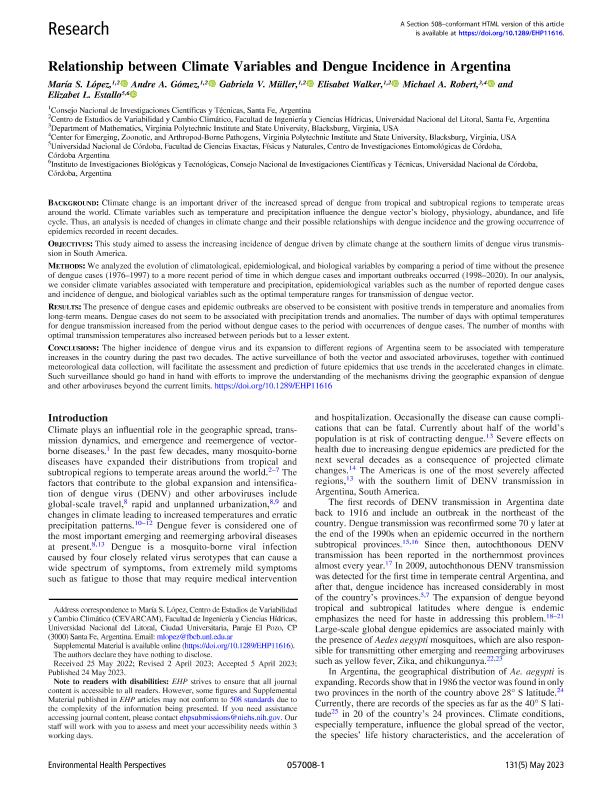Mostrar el registro sencillo del ítem
dc.contributor.author
López, María Soledad
dc.contributor.author
Gomez, Andrea Alejandra

dc.contributor.author
Muller, Gabriela Viviana

dc.contributor.author
Walker, Elisabet

dc.contributor.author
Robert, Michael A.
dc.contributor.author
Estallo, Elizabet Lilia

dc.date.available
2024-01-29T14:41:42Z
dc.date.issued
2023-05
dc.identifier.citation
López, María Soledad; Gomez, Andrea Alejandra; Muller, Gabriela Viviana; Walker, Elisabet; Robert, Michael A.; et al.; Relationship between Climate Variables and Dengue Incidence in Argentina; U.S. Department of Health and Human Sciences. Public Health and Science; Environmental Health Perspectives; 131; 5; 5-2023; 1-9
dc.identifier.issn
0091-6765
dc.identifier.uri
http://hdl.handle.net/11336/225080
dc.description.abstract
BACKGROUND: Climate change is an important driver of the increased spread of dengue from tropical and subtropical regions to temperate areas around the world. Climate variables such as temperature and precipitation influence the dengue vector’s biology, physiology, abundance, and life cycle. Thus, an analysis is needed of changes in climate change and their possible relationships with dengue incidence and the growing occurrence of epidemics recorded in recent decades. OBJECTIVES: This study aimed to assess the increasing incidence of dengue driven by climate change at the southern limits of dengue virus transmission in South America. METHODS: We analyzed the evolution of climatological, epidemiological, and biological variables by comparing a period of time without the presence of dengue cases (1976–1997) to a more recent period of time in which dengue cases and important outbreaks occurred (1998–2020). In our analysis, we consider climate variables associated with temperature and precipitation, epidemiological variables such as the number of reported dengue cases and incidence of dengue, and biological variables such as the optimal temperature ranges for transmission of dengue vector. RESULTS: The presence of dengue cases and epidemic outbreaks are observed to be consistent with positive trends in temperature and anomalies from long-term means. Dengue cases do not seem to be associated with precipitation trends and anomalies. The number of days with optimal temperatures for dengue transmission increased from the period without dengue cases to the period with occurrences of dengue cases. The number of months with optimal transmission temperatures also increased between periods but to a lesser extent. CONCLUSIONS: The higher incidence of dengue virus and its expansion to different regions of Argentina seem to be associated with temperature increases in the country during the past two decades. The active surveillance of both the vector and associated arboviruses, together with continued meteorological data collection, will facilitate the assessment and prediction of future epidemics that use trends in the accelerated changes in climate. Such surveillance should go hand in hand with efforts to improve the understanding of the mechanisms driving the geographic expansion of dengue and other arboviruses beyond the current limits. https://doi.org/10.1289/EHP11616.
dc.format
application/pdf
dc.language.iso
eng
dc.publisher
U.S. Department of Health and Human Sciences. Public Health and Science

dc.rights
info:eu-repo/semantics/openAccess
dc.rights.uri
https://creativecommons.org/licenses/by-nc-sa/2.5/ar/
dc.subject
CLIMATE CHANGE
dc.subject
DENGUE
dc.subject
CLIMATIC ANOMALIES
dc.subject.classification
Meteorología y Ciencias Atmosféricas

dc.subject.classification
Ciencias de la Tierra y relacionadas con el Medio Ambiente

dc.subject.classification
CIENCIAS NATURALES Y EXACTAS

dc.title
Relationship between Climate Variables and Dengue Incidence in Argentina
dc.type
info:eu-repo/semantics/article
dc.type
info:ar-repo/semantics/artículo
dc.type
info:eu-repo/semantics/publishedVersion
dc.date.updated
2024-01-26T11:11:01Z
dc.journal.volume
131
dc.journal.number
5
dc.journal.pagination
1-9
dc.journal.pais
Estados Unidos

dc.journal.ciudad
Research Triangle Park
dc.description.fil
Fil: López, María Soledad. Universidad Nacional del Litoral. Facultad de Ingenieria y Ciencias Hidricas. Centro de Estudios de Variabilidad y Cambio Climatico.; Argentina
dc.description.fil
Fil: Gomez, Andrea Alejandra. Consejo Nacional de Investigaciones Científicas y Técnicas. Centro Científico Tecnológico Conicet - Santa Fe; Argentina. Universidad Nacional del Litoral. Facultad de Ingenieria y Ciencias Hidricas. Centro de Estudios de Variabilidad y Cambio Climatico.; Argentina
dc.description.fil
Fil: Muller, Gabriela Viviana. Consejo Nacional de Investigaciones Científicas y Técnicas. Centro Científico Tecnológico Conicet - Santa Fe; Argentina. Universidad Nacional del Litoral. Facultad de Ingenieria y Ciencias Hidricas. Centro de Estudios de Variabilidad y Cambio Climatico.; Argentina
dc.description.fil
Fil: Walker, Elisabet. Consejo Nacional de Investigaciones Científicas y Técnicas. Centro Científico Tecnológico Conicet - Santa Fe; Argentina. Universidad Nacional del Litoral. Facultad de Ingenieria y Ciencias Hidricas. Centro de Estudios de Variabilidad y Cambio Climatico.; Argentina
dc.description.fil
Fil: Robert, Michael A.. Virginia Polytechnic Institute; Estados Unidos
dc.description.fil
Fil: Estallo, Elizabet Lilia. Consejo Nacional de Investigaciones Científicas y Técnicas. Centro Científico Tecnológico Conicet - Córdoba. Instituto de Investigaciones Biológicas y Tecnológicas. Universidad Nacional de Córdoba. Facultad de Ciencias Exactas, Físicas y Naturales. Instituto de Investigaciones Biológicas y Tecnológicas; Argentina. Universidad Nacional de Córdoba. Facultad de Ciencias Exactas, Físicas y Naturales. Centro de Investigaciones Entomológicas de Córdoba; Argentina
dc.journal.title
Environmental Health Perspectives

dc.relation.alternativeid
info:eu-repo/semantics/altIdentifier/url/https://ehp.niehs.nih.gov/doi/10.1289/EHP11616
dc.relation.alternativeid
info:eu-repo/semantics/altIdentifier/doi/http://dx.doi.org/10.1289/EHP11616
Archivos asociados
